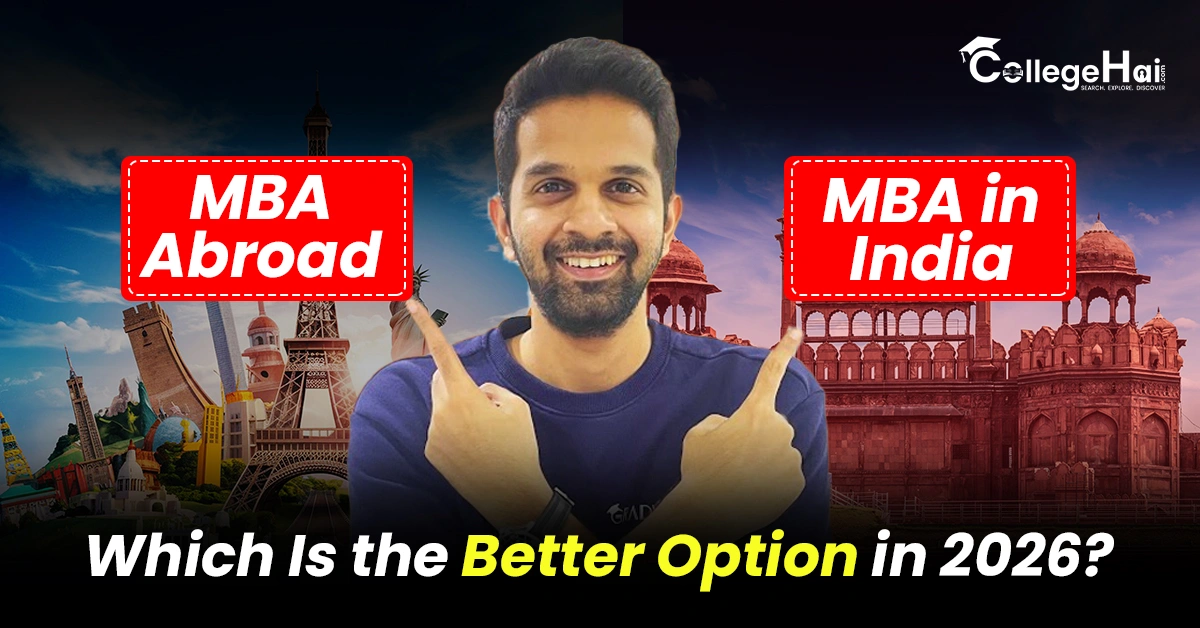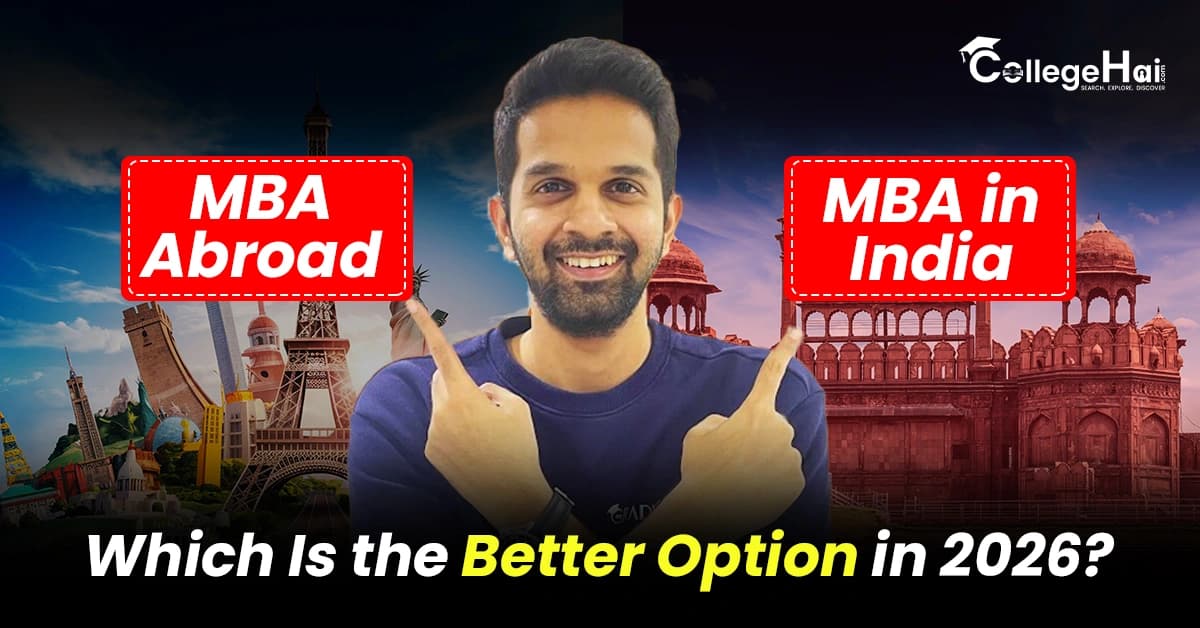In 2026, the MBA crossroads will be more than ever for aspiring Indian professionals who want to be leaders in an evolving global economy. One of the avenues is to the international campuses like Harvard, Stanford, or INSEAD, and it guarantees the incomparable borderless networks, immersion in cultures, and life-changing, transformative experiences.
The other route is secured in the elite strength of the B-schools of India, be it IIM Ahmedabad, Bangalore, or Calcutta, which offer outstanding value, smooth cultural fit, and rocket-fueled career development in a booming economy. As CAT applications are taking off to new record highs and international visa regulations are being tightened due to geopolitical changes, this decision will not be just a prestige one; it will be a long-term career investment.
How about getting a thorough, line-by-line examination of expenses, wages, profits (ROI), admissions, programs, and results from the most recent placement reports and fee schedules? It doesn't matter if your goal is to work in a top-tier consulting firm in London or to be the CEO of a fintech unicorn in Bengaluru. The information is there to help you decide the most intelligent and rewarding way.
Cost Analysis: India Wins the Battle of Affordability
The economic gap in 2026 will still be impressively huge, but the best programs in India are always offering elite education of the highest quality without having to empty your wallet or get into debts that would bury you.
MBA in India: Smart Aspirants Investment is worth trying.
The best bang for your buck is found at the flagship 2-year MBA programs at the IIMs:
IIM Ahmedabad: INR 26-27 lakh overall (including tuition, hostel, and essentials).
IIM Bangalore: INR 26 lakh inclusive.
IIM Calcutta: INR 27 lakh all-inclusive package
Add incidental extras such as mess fees and study materials INR 3-5 lakh. On-campus accommodation makes monthly payments small at INR 15-30k in safe hostels. The overall price would range between INR 30-40 lakh, which would usually be supplemented with generous merit-based scholarships up to a 100 percent waiver for the best students.
Select 2-year US courses or 1-year accelerated courses (assume INSEAD or LBS), and be prepared to pay a lavish and yet intensive sum:
Harvard/Stanford/Wharton: Tuition fee alone (at least) $157,000-171,000 (approximately) = INR 1.4-1.5 crore at present INR 88/USD exchange rates. Cost of living: 40-80k of annual expenditure in colorful and costly towns.
INSEAD (1-year intensive): Tuition fee EUR 107,600 (around INR 95 lakh all in all).
LBS (15-21 months flexible): The tuition fee is 119,950 (around INR 1.4 crore).
Total foreign investment: INR 1.5-2.5 crore, which includes visas, inclusive health insurance, and relocation. The bright spot here is that the competitive scholarships, such as Fulbright or INSEAD Diversity awards, can reduce the costs by 20-50% for exceptional Indian applicants.
ROI & Salaries: Rapid Recovery

ROI, being (Average CTC / Total Cost) x 100, illustrates that India is strong in terms of rapid financial recovery, whereas overseas is strong in terms of lifetime earnings potential, compounded increases, and bonuses.
India: 1-2 Years Recovery to Immediate Financial Freedom
Mean CTC: INR 30-35 LPA between batches (IIM Ahmedabad: INR 35 LPA; Bangalore: INR 35 LPA; Calcutta: INR 34 LPA).
Top Payments: INR 1-1.5 crore (consulting or tech occasional international positions).
ROI Metrics: 100-150% within the first year; full payback within 2 years or so, with room to make early investments or support the family.
Real-life Case Study: An IIM Bangalore graduate had an easy time recouping their INR 26 lakh investment in only around 9 months, in the form of a high-paying BCG consulting job.
International: 2-4 Years Breakeven
Entry Level Pay: $175-205k (approximately INR 1.5-1.8 crore) with substantial signing bonuses of $30-50k (Harvard/Stanford standards).
INSEAD Graduates: EUR 111,400 mean (approximately INR 1 crore).
LBS Alumni: $116,465 (approximately INR 1 crore).
ROI Trajectory: 80-100% in Year 1, cumulative 3-year returns are often more than 3 times the initial investment due to fast promotions.
The high taxes overseas are compensated by high yearly increases, which make it a marathon winner in accumulating wealth.
Selection Process: India vs Abroad
India Process of Admission: Process is highly CAT-based, requires IIM calls of 99+ percentiles, followed by WAT/GD/PI. Work experience of 0-5 years, with a focus on academic excellence and diversity.
The Strategy of Abroad: GMAT/GRE scores (700+ goals), persuasive essays with leadership experiences, effective recommendation letters, and in-depth interviews. Common condition, 3-7 years of professional experience; extreme emphasis on personal impact and diversity.
Emerging Shift 2026: Indian B-schools are now embracing GRE to reach more; global programs are placing more emphasis on impact essays of the AI-era, with a focus on tech-competent innovations.
Curriculum and Learning Experience: India vs Abroad
The MBA curriculum is the potential where your leadership steel is tempered. Indian and global B-schools both teach finance, marketing, and strategy, but the way they do it makes you what you are.
MBA in India: Disciplined and Result-Oriented.
The best schools, such as IIM Ahmedabad, Bangalore, and Calcutta, are exam-oriented and competitive. Classrooms are filled with demanding case studies, be it of the disruption of Jio in the market or the green efforts of Adani, combined with strict deadlines, lengthy assignments, and assessments.
The curriculum is generally structured to have 70 percent core and 30 percent electives with a focus on such areas as rural supply chains, regulatory frameworks, and the rapidly changing economy of India. It would suit people who want to be leading in the dynamic industries of India, either as a CEO of a fintech startup in Bengaluru or as a consulting partner in Mumbai.
MBA Global and Transformative Abroad.
In the best schools of the world, like Harvard, INSEAD, or London Business School, the method is much more flexible and experiential. Having almost 60% electives, students have an opportunity to major in such contemporary subjects as AI ethics, sustainability, or venture capital. The learning occurs in the form of Socratic discussions, real-world projects with clients, and case studies with companies such as Tesla to Alibaba.
It is a highly multicultural experience; you will work with students of more than 50 nationalities, under the guidance of world-renowned economists and business leaders, developing the competencies to work across borders and industries.
Placement Powerhouses: Who Makes the Profitable Jumps?
Placements are not just paychecks but career-launching pads that make legacies. Indian and international MBA programs are equally good in terms of results, but their scope and payoffs are varied.
India's Domestic Powerhouse
Even the leading Indian B-schools, such as IIM Ahmedabad, Bangalore, and Calcutta, are recording 100 percent placement with the confidence of recruiters being unparalleled.
IIM Ahmedabad (2025): More than 200 recruiters, such as McKinsey, BCG, and Goldman Sachs, were offering packages above INR 30 LPA. Sector split: Consulting: 40, Finance: 25, Tech: 20. International (UAE, Singapore) offers are about 10-15% with an average of INR 1 Cr+.
IIM Bangalore: 137 recruiters, median package INR 31 LPA. The top of the list was occupied by Bain & Company and Amazon.
IIM Calcutta: 196 companies took part, and Google and Microsoft were the leading recruiters. The top 10% earned around INR 73 LPA.
The number of women hired increased by 25 percent, and diversity efforts are thriving. The majority of graduates, almost 80 percent of them, stay in India, which builds leadership networks at home.
Abroad’s Global Goldmine
The best foreign B-schools are open to world leadership positions with six-figure pay and global experience.
Harvard (Class of 2024): Median base salary is $175,000, and 86% of them are given signing bonuses with an average of 30,000. Hiring is dominated by consulting (25%) and PE/VC (33%).
Stanford GSB: Median salary $185,500, finance jobs reaching 200,000.
Wharton: Median salary is $180,000, with 85% bonuses.
INSEAD: EUR 111,400 Median CTC (INR 1 Cr), consulting positions with an average of 125,000 dollars.
London Business School (LBS): PS 116,000 mean, and 33 percent post-MBA pay raise.
Post-study work visas, US OPT (3 years STEM), and UK PSW (2 years) are designed to allow graduates to have global exposure. Approximately 70 percent of them remain outside the country after an MBA, and the returning graduates in India have 50 percent salary premiums.
Comparison of MBA Placement: India vs Abroad.
The 2026 Verdict
An MBA in India is ideal when it comes to cost-effective professionals who want to get quick payback and dominate the fast-growing industries in India, such as technology, finance, and e-commerce. In contrast, an MBA in a foreign country is ideal for individuals who want to work in international positions, have cross-border experience, and pursue international development in the long term.
Though there are still obstacles, such as uncertainty about the visa and expensive education loans may impact ROI on international programs. Nevertheless, with the increasing popularity of AI ethics and sustainable business courses around the world, India may reconsider its inclusive development and rural innovation as the key to its competitive advantage by 2026.
Possible Trends in MBA Education
The environment of MBA is changing rapidly, and the factors affecting it are the outcome of technology, globalization, and changing industry demands. The Curriculum is increasingly focused on digital transformation, data analytics, and artificial intelligence, and social impact courses are becoming more popular.
Online and hybrid MBAs are becoming more popular among professionals who want to have a flexible learning experience without the need to compromise on quality. Academies are also paying more attention to cross-cultural leadership, entrepreneurship, and international cooperation. The development of edtech platforms and focused MBAs in fields like fintech, healthcare, and business analytics is a sign of a new age in India. The future MBA will equip leaders to be successful in a dynamic, interconnected world.
Conclusion
An MBA in India or in a foreign country is not merely a degree, but it is a career-making experience. The Indian programs are affordable, well-networked with the local industry, and offer opportunities in an economy with high growth, and the foreign universities are international, have a wide network, and offer access to multinational employment.
It is not one way or another; it is just that you need to make the choice that fits your own aspirations and financial possibilities, and long-term vision. With the right planning and recognition, an MBA could result in leadership, innovation, and global impact, and you can make your future.
About the Author

Content Writer
Priya is a passionate content writer with 2 years of experience in freelancing, who enjoys creating simple, clear and engaging content for readers. She loves writing blogs, articles, and web content that share useful ideas in a easy way. Always curious to learn new things and believes good writing hepls people connect and learn better.Read More



